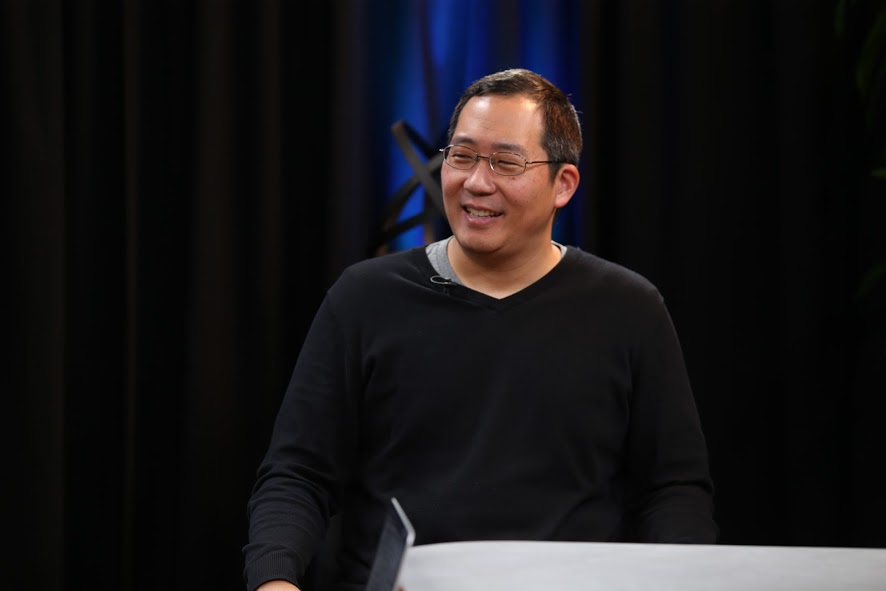 EMERGING TECH
EMERGING TECH
 EMERGING TECH
EMERGING TECH
 EMERGING TECH
EMERGING TECH
Chris Yeh (pictured) graduated from Stanford University at the age of 19, published a popular book called “Blitzscaling,” and has built a number of internet businesses since 1995. But does he know how to answer 12 tough questions perfectly in five minutes while strapped to a robot-controlled chair swinging through the caverns of a dark studio in front of millions of TV viewers?
The world is about to find out. On April 30, Yeh will appear as a contestant on the new Fox TV game-show program “Mental Samurai.” His segment has already been taped and he his sworn to secrecy, but he did divulge that he now knows what it must feel like to be an astronaut.
“Every run starts with you facing straight up, lying back as if you’re going to be launched in a rocket,” Yeh said. “You’re answering these difficult questions, with time pressure, and then there’s Rob Lowe as well, who you’re having a conversation with. My heart was pounding. I was trying very hard to stay calm.”
Yeh spoke with John Furrier (@furrier), host of theCUBE, SiliconANGLE Media’s mobile livestreaming studio, at theCUBE’s studio in Palo Alto, California. They discussed similarities between Yeh’s new TV experience and the startup community, lessons from his book on “blitzscaling,” and the challenges of navigating growth in a rapidly moving tech world (see the full interview with transcript here).
Yeh’s fledging TV career represents an interesting diversion from his role as general partner at Wasabi Ventures Global and current work assisting rapidly growing companies to achieve and maintain success. The parallels are hard to miss.
“There actually are a lot of similarities between the startup world and ‘Mental Samurai,’” explained Yeh, who cited the importance of moving as quickly as possible while remaining accurate. “The one difference of course is in our startup world, you often do make mistakes and you have a chance to recover from them. But in ‘Mental Samurai,” you have to be perfect.”
When he’s not swinging through the air on a robotic arm and conversing with Rob Lowe, Yeh spends his time talking about blitzscaling, how startup firms can become first to scale in a winner-take-most or winner-take-all market. The concept of blitzscaling came from a series of video-taped lectures delivered at a Stanford class during 2015 that was taught by Yeh and LinkedIn co-founder Reid Hoffman.
The class featured presentations from executives associated with blitzscaling companies and included Google LLC’s Eric Schmidt and Airbnb Inc.’s Brian Chesky. “All of those conversations really formed a key part of the raw material that went into the book,” Yeh said. “We began to see patterns emerge.”
One of those patterns was that many companies that can successfully blitzscale originate as some of the stupidest-sounding ideas ever proposed. Uber, a ride-sharing fleet of personally owned cars that can only be ordered on mobile phones? Airbnb, a network of rooms in private homes and apartments rented out to complete strangers?
“One of the things that Reid likes to say is that the best possible companies usually sound like they’re dumb ideas,” Yeh said. “In fact, the best investments he’s been a part of as a venture capitalist are the ones where there’s the greatest controversy around the table.”
The market dynamics of blitzscaling have played out beyond the startup world as well. An example of this can be found in the decision by Michael Dell to take his company off the public market in 2013. It allowed Dell Inc. to transform from a struggling consumer tech business into a major enterprise player.
“One of the reasons why somebody like Michael Dell went private to do this is that blitzscaling is all about prioritizing speed over efficiency,” Yeh said. “Guess who doesn’t like that? Wall Street, because you’re taking a hit to earnings as you invest in new business.”
Blitzscaling is not for everyone, as Yeh freely admits. “The thing about blitzscaling is it’s very risky; it takes a lot of effort and is very uncomfortable,” Yeh said. “It’s only worth doing when you have market dynamics and that market is really large.”
Watch the complete video interview below, and be sure to check out more of SiliconANGLE’s and theCUBE’s CUBE Conversations.
THANK YOU